Mounted Calcite Glan-Thompson Polarizers
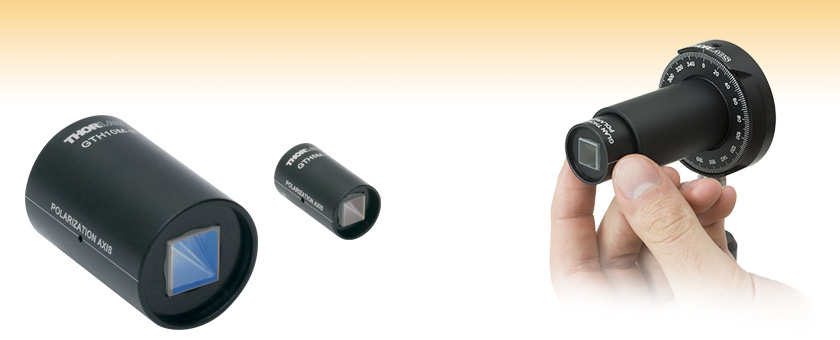
- Wide Field of View: 40° Typical
- Highest Grade Optical Calcite
- Ø1/2" or Ø1" Outer Diameter Mount
- Uncoated and AR-Coated Versions Available
GTH10M-B
GTH5M-A
Application Idea
GTH10M Polarizer, SM1L20 Lens Tube,
and RSP1 Rotation Mount Assembly

Please Wait
| Item # Prefix | GTH5M | GTH10M |
|---|---|---|
| Extinction Ratioa | 100 000:1 | |
| Substrate | High Optical Grade Calciteb | |
| Wavefront Distortion |
≤λ/4 Over Clear Aperture | |
| Surface Qualityc | 20-10 Scratch-Dig | |
| Wavelength Range | 350 nm to 2.3 µm | |
| Aperture | 5.0 mm x 5.0 mm | 10.0 mm x 10.0 mm |
| Dimensionsd | ||
| A | 21.6 mm | 36.6 mm |
| B | 12.7 mm | 25.4 mm |
| Damage Thresholdse | ||
| Pulsed | 2 J/cm2 (1064 nm, 10 ns, 10 Hz, Ø0.476 mm) | |
| CW | 2 kW/cm (1064 nm, Ø0.092 mm) | |
Features
- Wide Field of View: 40° Typical (FOV1 + FOV2; See Calcite Tab)
- High Extinction Ratio: 100 000:1
- 350 nm to 2.3 μm Operation for Uncoated Prisms
- AR-Coated Versions for 350 - 700 nm or 650 - 1050 nm Range
- Highest Grade Optical Calcite
- Cemented Prisms
Thorlabs' Mounted Glan-Thompson calcite polarizers offer the widest field of view of the calcite polarizers while maintaining a high extinction ratio. The mounts consist of a black aluminum housing; unmounted versions are also available. The mounted GTH5M polarizer has a 1/2" outer diameter and can be conveniently held inside our SM05L10 lens tube. This allows the user to easily mount this polarizer to a rotation stage, such as the PRM05 Precision Rotation Mount for Ø1/2" optics. A similar option is available for the 1" outer diameter GTH10M mounted polarizer, using the SM1L20 lens tube and PRM1 precision rotation mount. Please see the Mounting tab for more details.
Both uncoated and AR coated polarizers are available. The uncoated polarizers are designed for use in the 350 nm to 2.3 μm range, while coated versions offer Ravg < 1% per surface in the 350 - 700 nm or 650 - 1050 nm wavelength range. Please see the Graphs tab for coating reflectivity data.
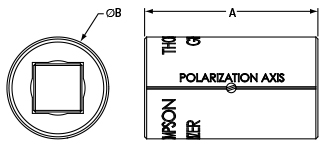
Glan-Thompson polarizers consist of two cemented prisms made from the highest optical grade of calcite. Unpolarized light enters the polarizer and is split at the interface between the two crystals. The ordinary rays are reflected at each interface, causing them to be scattered and partially absorbed by the polarizer housing. The extraordinary rays pass straight through the polarizer, providing a polarized output.
Note: As with all Glan-Thompson polarizers, the maximum optical intensity is limited by the cemented prism interface. For high-power applications, Thorlabs offers Glan-Laser polarizers, which can handle energy densities up to 20 J/cm2.
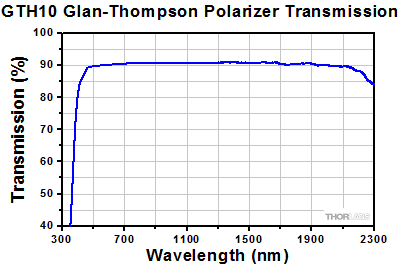
Click to Enlarge
Click Here for Raw Data
The transmission graph above shows the typical transmission of an uncoated GTH10 Glan-Thompson Calcite Polarizer (mounted Item # GTH10M), including any internal losses. The transmission is valid for linearly polarized light aligned with the mark on the housing of the polarizer. Calcite is a natural material, and thus transmission can vary significantly, particularly in the UV and IR. Consequently, the performance data shown above may vary from lot to lot and is not guaranteed.
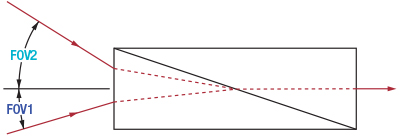
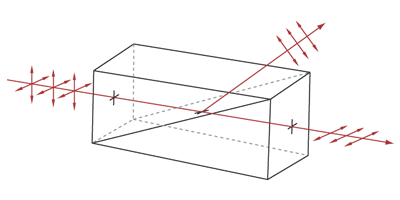
Polarization-Dependent Refraction - Glan-Thompson Calcite Polarizer
Our calcite polarizers are all based on high-grade, birefringent calcite crystals. Due to the birefringent nature of calcite, waves polarized in the direction of the optical axis propagate with a different index of refraction than waves polarized orthogonally to the optical axis. In our mounted Glan-Thompson polarizers, this birefringence causes the selective reflection and absorption of one polarization state of an incident beam and the transmission of the other orthogonal polarization state. When unpolarized light is incident on the optic, extraordinary rays pass straight through the polarizer while ordinary rays are reflected at an angle that depends on the light's wavelength and the length of the polarizer. The reflected ordinary rays are then scattered and partially absorbed by the optic's housing, resulting in a highly polarized output.
A calcite polarizer can be designed as either a polarization splitter/combiner or as a polarizer element that removes the angled, orthogonally polarized component of a beam. Our calcite polarizers are typically built out of two prisms, as shown in the drawing to the right. Since calcite is a soft crystal that is easily damaged, almost all of our calcite polarizers are offered in metal housings. With convenient threadings and adapters, these housings can easily be mounted into our opto-mechanical products.
Field of View
Calcite polarizers feature a field of view (FOV) that varies with both wavelength and entrance orientation. The FOV of these prisms must be considered during alignment and collimation procedures.
The side that absorbs the ordinary ray has an FOV that decreases as the wavelength increases (FOV 1). The opposite side has an FOV that increases as the wavelength increases (FOV 2). The FOV of Glan-Thompson polarizers is typically greater than the FOV of Glan-Taylor polarizers.

Calcite Polarizer Field of View (FOV)
Transmission
Thorlabs uses only the highest quality natural calcite in our polarizing prisms. Typical transmission curves for these polarizers may be found on the Graphs tab. Because calcite is a naturally occuring material, variations in the crystal affect the transmission curve and the damage threshold rating. Variations in the calcite transmission curve are typically limited to wavelengths > 2 μm, making calcite an excellent material to use in the visible and NIR.
| Thorlabs' Calcite Polarizers | ||
|---|---|---|
| Glan-Laser Polarizers | Glan-Taylor Polarizers | Wollaston Polarizers |
| Mounted Glan-Thompson Polarizers Unmounted Glan-Thompson Polarizers |
Double Glan-Taylor Polarizer | Beam Displacers |
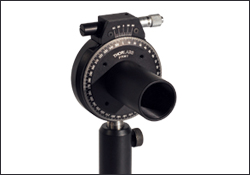
Figure 2
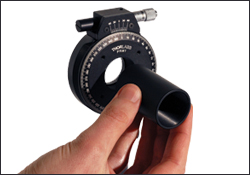
Figure 1
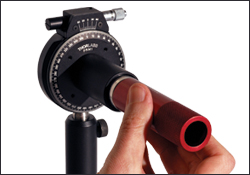
Figure 4
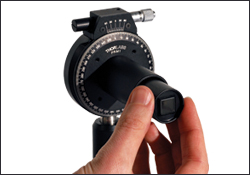
Figure 3
Mounting the GTH10M
The GTH10M polarizer can be mounted to a PRM1 rotation mount by using a SM1L20 lens tube:
- Remove the retaining rings that comes with the PRM1 rotation mount and the lens tube.
- Screw the threaded end of the lens tube into the rotation mount as shown in Figure 1.
- Once the lens tube is threaded (Figure 2), insert the mounted polarizer into the other end of the lens tube (see Figure 3)
- Secure the polarizer into place using the retaining ring included with the lens tube.
- A SPW602 spanner wrench can be used to tighten the retaining ring (Figure 4).
Note: The SM1P1 Ø1" to SM1 adapter can be used in place of the SM1L20 lens tube when space is not available for the extra length of the lens tube.
Mounting the GTH5M
The GTH5M can be mounted using the directions above for the GTH10M, except substituting Ø1/2" components for the Ø1" components used for the GTH10M. The chart below lists the equivalent item numbers appropriate for mounting the GTH5M.
| Damage Threshold Specifications | |
|---|---|
| Laser Output | Damage Thresholda |
| Pulsed | 2 J/cm2 at 1064 nm, 10 ns, 10 Hz, Ø0.476 mm |
| CWb | 2 kW/cm at 1064 nm, Ø0.092 mm |
Damage Threshold Data for Thorlabs' Glan-Thompson Polarizers
The specifications to the right are measured data for Thorlabs' Glan-Thompson polarizers. Damage threshold specifications are constant for all Glan-Thompson polarizers, regardless of the size or coating, as the limiting factor is the cement rather than the coating.
Laser Induced Damage Threshold Tutorial
The following is a general overview of how laser induced damage thresholds are measured and how the values may be utilized in determining the appropriateness of an optic for a given application. When choosing optics, it is important to understand the Laser Induced Damage Threshold (LIDT) of the optics being used. The LIDT for an optic greatly depends on the type of laser you are using. Continuous wave (CW) lasers typically cause damage from thermal effects (absorption either in the coating or in the substrate). Pulsed lasers, on the other hand, often strip electrons from the lattice structure of an optic before causing thermal damage. Note that the guideline presented here assumes room temperature operation and optics in new condition (i.e., within scratch-dig spec, surface free of contamination, etc.). Because dust or other particles on the surface of an optic can cause damage at lower thresholds, we recommend keeping surfaces clean and free of debris. For more information on cleaning optics, please see our Optics Cleaning tutorial.
Testing Method
Thorlabs' LIDT testing is done in compliance with ISO/DIS 11254 and ISO 21254 specifications.
First, a low-power/energy beam is directed to the optic under test. The optic is exposed in 10 locations to this laser beam for 30 seconds (CW) or for a number of pulses (pulse repetition frequency specified). After exposure, the optic is examined by a microscope (~100X magnification) for any visible damage. The number of locations that are damaged at a particular power/energy level is recorded. Next, the power/energy is either increased or decreased and the optic is exposed at 10 new locations. This process is repeated until damage is observed. The damage threshold is then assigned to be the highest power/energy that the optic can withstand without causing damage. A histogram such as that below represents the testing of one BB1-E02 mirror.

The photograph above is a protected aluminum-coated mirror after LIDT testing. In this particular test, it handled 0.43 J/cm2 (1064 nm, 10 ns pulse, 10 Hz, Ø1.000 mm) before damage.

| Example Test Data | |||
|---|---|---|---|
| Fluence | # of Tested Locations | Locations with Damage | Locations Without Damage |
| 1.50 J/cm2 | 10 | 0 | 10 |
| 1.75 J/cm2 | 10 | 0 | 10 |
| 2.00 J/cm2 | 10 | 0 | 10 |
| 2.25 J/cm2 | 10 | 1 | 9 |
| 3.00 J/cm2 | 10 | 1 | 9 |
| 5.00 J/cm2 | 10 | 9 | 1 |
According to the test, the damage threshold of the mirror was 2.00 J/cm2 (532 nm, 10 ns pulse, 10 Hz, Ø0.803 mm). Please keep in mind that these tests are performed on clean optics, as dirt and contamination can significantly lower the damage threshold of a component. While the test results are only representative of one coating run, Thorlabs specifies damage threshold values that account for coating variances.
Continuous Wave and Long-Pulse Lasers
When an optic is damaged by a continuous wave (CW) laser, it is usually due to the melting of the surface as a result of absorbing the laser's energy or damage to the optical coating (antireflection) [1]. Pulsed lasers with pulse lengths longer than 1 µs can be treated as CW lasers for LIDT discussions.
When pulse lengths are between 1 ns and 1 µs, laser-induced damage can occur either because of absorption or a dielectric breakdown (therefore, a user must check both CW and pulsed LIDT). Absorption is either due to an intrinsic property of the optic or due to surface irregularities; thus LIDT values are only valid for optics meeting or exceeding the surface quality specifications given by a manufacturer. While many optics can handle high power CW lasers, cemented (e.g., achromatic doublets) or highly absorptive (e.g., ND filters) optics tend to have lower CW damage thresholds. These lower thresholds are due to absorption or scattering in the cement or metal coating.

LIDT in linear power density vs. pulse length and spot size. For long pulses to CW, linear power density becomes a constant with spot size. This graph was obtained from [1].

Pulsed lasers with high pulse repetition frequencies (PRF) may behave similarly to CW beams. Unfortunately, this is highly dependent on factors such as absorption and thermal diffusivity, so there is no reliable method for determining when a high PRF laser will damage an optic due to thermal effects. For beams with a high PRF both the average and peak powers must be compared to the equivalent CW power. Additionally, for highly transparent materials, there is little to no drop in the LIDT with increasing PRF.
In order to use the specified CW damage threshold of an optic, it is necessary to know the following:
- Wavelength of your laser
- Beam diameter of your beam (1/e2)
- Approximate intensity profile of your beam (e.g., Gaussian)
- Linear power density of your beam (total power divided by 1/e2 beam diameter)
Thorlabs expresses LIDT for CW lasers as a linear power density measured in W/cm. In this regime, the LIDT given as a linear power density can be applied to any beam diameter; one does not need to compute an adjusted LIDT to adjust for changes in spot size, as demonstrated by the graph to the right. Average linear power density can be calculated using the equation below.

The calculation above assumes a uniform beam intensity profile. You must now consider hotspots in the beam or other non-uniform intensity profiles and roughly calculate a maximum power density. For reference, a Gaussian beam typically has a maximum power density that is twice that of the uniform beam (see lower right).
Now compare the maximum power density to that which is specified as the LIDT for the optic. If the optic was tested at a wavelength other than your operating wavelength, the damage threshold must be scaled appropriately. A good rule of thumb is that the damage threshold has a linear relationship with wavelength such that as you move to shorter wavelengths, the damage threshold decreases (i.e., a LIDT of 10 W/cm at 1310 nm scales to 5 W/cm at 655 nm):

While this rule of thumb provides a general trend, it is not a quantitative analysis of LIDT vs wavelength. In CW applications, for instance, damage scales more strongly with absorption in the coating and substrate, which does not necessarily scale well with wavelength. While the above procedure provides a good rule of thumb for LIDT values, please contact Tech Support if your wavelength is different from the specified LIDT wavelength. If your power density is less than the adjusted LIDT of the optic, then the optic should work for your application.
Please note that we have a buffer built in between the specified damage thresholds online and the tests which we have done, which accommodates variation between batches. Upon request, we can provide individual test information and a testing certificate. The damage analysis will be carried out on a similar optic (customer's optic will not be damaged). Testing may result in additional costs or lead times. Contact Tech Support for more information.
Pulsed Lasers
As previously stated, pulsed lasers typically induce a different type of damage to the optic than CW lasers. Pulsed lasers often do not heat the optic enough to damage it; instead, pulsed lasers produce strong electric fields capable of inducing dielectric breakdown in the material. Unfortunately, it can be very difficult to compare the LIDT specification of an optic to your laser. There are multiple regimes in which a pulsed laser can damage an optic and this is based on the laser's pulse length. The highlighted columns in the table below outline the relevant pulse lengths for our specified LIDT values.
Pulses shorter than 10-9 s cannot be compared to our specified LIDT values with much reliability. In this ultra-short-pulse regime various mechanics, such as multiphoton-avalanche ionization, take over as the predominate damage mechanism [2]. In contrast, pulses between 10-7 s and 10-4 s may cause damage to an optic either because of dielectric breakdown or thermal effects. This means that both CW and pulsed damage thresholds must be compared to the laser beam to determine whether the optic is suitable for your application.
| Pulse Duration | t < 10-9 s | 10-9 < t < 10-7 s | 10-7 < t < 10-4 s | t > 10-4 s |
|---|---|---|---|---|
| Damage Mechanism | Avalanche Ionization | Dielectric Breakdown | Dielectric Breakdown or Thermal | Thermal |
| Relevant Damage Specification | No Comparison (See Above) | Pulsed | Pulsed and CW | CW |
When comparing an LIDT specified for a pulsed laser to your laser, it is essential to know the following:

LIDT in energy density vs. pulse length and spot size. For short pulses, energy density becomes a constant with spot size. This graph was obtained from [1].
- Wavelength of your laser
- Energy density of your beam (total energy divided by 1/e2 area)
- Pulse length of your laser
- Pulse repetition frequency (prf) of your laser
- Beam diameter of your laser (1/e2 )
- Approximate intensity profile of your beam (e.g., Gaussian)
The energy density of your beam should be calculated in terms of J/cm2. The graph to the right shows why expressing the LIDT as an energy density provides the best metric for short pulse sources. In this regime, the LIDT given as an energy density can be applied to any beam diameter; one does not need to compute an adjusted LIDT to adjust for changes in spot size. This calculation assumes a uniform beam intensity profile. You must now adjust this energy density to account for hotspots or other nonuniform intensity profiles and roughly calculate a maximum energy density. For reference a Gaussian beam typically has a maximum energy density that is twice that of the 1/e2 beam.
Now compare the maximum energy density to that which is specified as the LIDT for the optic. If the optic was tested at a wavelength other than your operating wavelength, the damage threshold must be scaled appropriately [3]. A good rule of thumb is that the damage threshold has an inverse square root relationship with wavelength such that as you move to shorter wavelengths, the damage threshold decreases (i.e., a LIDT of 1 J/cm2 at 1064 nm scales to 0.7 J/cm2 at 532 nm):

You now have a wavelength-adjusted energy density, which you will use in the following step.
Beam diameter is also important to know when comparing damage thresholds. While the LIDT, when expressed in units of J/cm², scales independently of spot size; large beam sizes are more likely to illuminate a larger number of defects which can lead to greater variances in the LIDT [4]. For data presented here, a <1 mm beam size was used to measure the LIDT. For beams sizes greater than 5 mm, the LIDT (J/cm2) will not scale independently of beam diameter due to the larger size beam exposing more defects.
The pulse length must now be compensated for. The longer the pulse duration, the more energy the optic can handle. For pulse widths between 1 - 100 ns, an approximation is as follows:

Use this formula to calculate the Adjusted LIDT for an optic based on your pulse length. If your maximum energy density is less than this adjusted LIDT maximum energy density, then the optic should be suitable for your application. Keep in mind that this calculation is only used for pulses between 10-9 s and 10-7 s. For pulses between 10-7 s and 10-4 s, the CW LIDT must also be checked before deeming the optic appropriate for your application.
Please note that we have a buffer built in between the specified damage thresholds online and the tests which we have done, which accommodates variation between batches. Upon request, we can provide individual test information and a testing certificate. Contact Tech Support for more information.
[1] R. M. Wood, Optics and Laser Tech. 29, 517 (1998).
[2] Roger M. Wood, Laser-Induced Damage of Optical Materials (Institute of Physics Publishing, Philadelphia, PA, 2003).
[3] C. W. Carr et al., Phys. Rev. Lett. 91, 127402 (2003).
[4] N. Bloembergen, Appl. Opt. 12, 661 (1973).
In order to illustrate the process of determining whether a given laser system will damage an optic, a number of example calculations of laser induced damage threshold are given below. For assistance with performing similar calculations, we provide a spreadsheet calculator that can be downloaded by clicking the button to the right. To use the calculator, enter the specified LIDT value of the optic under consideration and the relevant parameters of your laser system in the green boxes. The spreadsheet will then calculate a linear power density for CW and pulsed systems, as well as an energy density value for pulsed systems. These values are used to calculate adjusted, scaled LIDT values for the optics based on accepted scaling laws. This calculator assumes a Gaussian beam profile, so a correction factor must be introduced for other beam shapes (uniform, etc.). The LIDT scaling laws are determined from empirical relationships; their accuracy is not guaranteed. Remember that absorption by optics or coatings can significantly reduce LIDT in some spectral regions. These LIDT values are not valid for ultrashort pulses less than one nanosecond in duration.

A Gaussian beam profile has about twice the maximum intensity of a uniform beam profile.
CW Laser Example
Suppose that a CW laser system at 1319 nm produces a 0.5 W Gaussian beam that has a 1/e2 diameter of 10 mm. A naive calculation of the average linear power density of this beam would yield a value of 0.5 W/cm, given by the total power divided by the beam diameter:

However, the maximum power density of a Gaussian beam is about twice the maximum power density of a uniform beam, as shown in the graph to the right. Therefore, a more accurate determination of the maximum linear power density of the system is 1 W/cm.
An AC127-030-C achromatic doublet lens has a specified CW LIDT of 350 W/cm, as tested at 1550 nm. CW damage threshold values typically scale directly with the wavelength of the laser source, so this yields an adjusted LIDT value:

The adjusted LIDT value of 350 W/cm x (1319 nm / 1550 nm) = 298 W/cm is significantly higher than the calculated maximum linear power density of the laser system, so it would be safe to use this doublet lens for this application.
Pulsed Nanosecond Laser Example: Scaling for Different Pulse Durations
Suppose that a pulsed Nd:YAG laser system is frequency tripled to produce a 10 Hz output, consisting of 2 ns output pulses at 355 nm, each with 1 J of energy, in a Gaussian beam with a 1.9 cm beam diameter (1/e2). The average energy density of each pulse is found by dividing the pulse energy by the beam area:

As described above, the maximum energy density of a Gaussian beam is about twice the average energy density. So, the maximum energy density of this beam is ~0.7 J/cm2.
The energy density of the beam can be compared to the LIDT values of 1 J/cm2 and 3.5 J/cm2 for a BB1-E01 broadband dielectric mirror and an NB1-K08 Nd:YAG laser line mirror, respectively. Both of these LIDT values, while measured at 355 nm, were determined with a 10 ns pulsed laser at 10 Hz. Therefore, an adjustment must be applied for the shorter pulse duration of the system under consideration. As described on the previous tab, LIDT values in the nanosecond pulse regime scale with the square root of the laser pulse duration:

This adjustment factor results in LIDT values of 0.45 J/cm2 for the BB1-E01 broadband mirror and 1.6 J/cm2 for the Nd:YAG laser line mirror, which are to be compared with the 0.7 J/cm2 maximum energy density of the beam. While the broadband mirror would likely be damaged by the laser, the more specialized laser line mirror is appropriate for use with this system.
Pulsed Nanosecond Laser Example: Scaling for Different Wavelengths
Suppose that a pulsed laser system emits 10 ns pulses at 2.5 Hz, each with 100 mJ of energy at 1064 nm in a 16 mm diameter beam (1/e2) that must be attenuated with a neutral density filter. For a Gaussian output, these specifications result in a maximum energy density of 0.1 J/cm2. The damage threshold of an NDUV10A Ø25 mm, OD 1.0, reflective neutral density filter is 0.05 J/cm2 for 10 ns pulses at 355 nm, while the damage threshold of the similar NE10A absorptive filter is 10 J/cm2 for 10 ns pulses at 532 nm. As described on the previous tab, the LIDT value of an optic scales with the square root of the wavelength in the nanosecond pulse regime:

This scaling gives adjusted LIDT values of 0.08 J/cm2 for the reflective filter and 14 J/cm2 for the absorptive filter. In this case, the absorptive filter is the best choice in order to avoid optical damage.
Pulsed Microsecond Laser Example
Consider a laser system that produces 1 µs pulses, each containing 150 µJ of energy at a repetition rate of 50 kHz, resulting in a relatively high duty cycle of 5%. This system falls somewhere between the regimes of CW and pulsed laser induced damage, and could potentially damage an optic by mechanisms associated with either regime. As a result, both CW and pulsed LIDT values must be compared to the properties of the laser system to ensure safe operation.
If this relatively long-pulse laser emits a Gaussian 12.7 mm diameter beam (1/e2) at 980 nm, then the resulting output has a linear power density of 5.9 W/cm and an energy density of 1.2 x 10-4 J/cm2 per pulse. This can be compared to the LIDT values for a WPQ10E-980 polymer zero-order quarter-wave plate, which are 5 W/cm for CW radiation at 810 nm and 5 J/cm2 for a 10 ns pulse at 810 nm. As before, the CW LIDT of the optic scales linearly with the laser wavelength, resulting in an adjusted CW value of 6 W/cm at 980 nm. On the other hand, the pulsed LIDT scales with the square root of the laser wavelength and the square root of the pulse duration, resulting in an adjusted value of 55 J/cm2 for a 1 µs pulse at 980 nm. The pulsed LIDT of the optic is significantly greater than the energy density of the laser pulse, so individual pulses will not damage the wave plate. However, the large average linear power density of the laser system may cause thermal damage to the optic, much like a high-power CW beam.
Polarizer Selection Guide
Thorlabs offers a diverse range of polarizers, including wire grid, film, calcite, alpha-BBO, rutile, and beamsplitting polarizers. Collectively, our line of wire grid polarizers offers coverage from the visible range to the beginning of the Far-IR range. Our nanoparticle linear film polarizers provide extinction ratios as high as 100 000:1. Alternatively, our other film polarizers offer an affordable solution for polarizing light from the visible to the Near-IR. Next, our beamsplitting polarizers allow for use of the reflected beam, as well as the more completely polarized transmitted beam. Finally, our alpha-BBO (UV), calcite (visible to Near-IR), rutile (Near-IR to Mid-IR), and yttrium orthovanadate (YVO4) (Near-IR to Mid-IR) polarizers each offer an exceptional extinction ratio of 100 000:1 within their respective wavelength ranges.
To explore the available types, wavelength ranges, extinction ratios, transmission, and available sizes for each polarizer category, click More [+] in the appropriate row below.
| Wire Grid Polarizers |
|---|
| Film Polarizers |
|---|
| Beamsplitting Polarizers |
|---|
| alpha-BBO Polarizers |
|---|
| Calcite Polarizers |
|---|
| Quartz Polarizers |
|---|
| Magnesium Fluoride Polarizers |
|---|
| Yttrium Orthovanadate (YVO4) Polarizers |
|---|
| Rutile Polarizers |
|---|
| Posted Comments: | |
Wolfgang Theiss
(posted 2020-10-26 14:59:53.4) I bought this product and had it shipped to Germany. Fedex is asking me for the TARIC number - can you help me?
Thanks
Wolfgang YLohia
(posted 2020-10-28 09:40:50.0) Hello Wolfgang, our German sales team would be happy to help you track your order: sales.de@thorlabs.com / +49 (0) 8131-5956-0. We will contact you directly. jouni.peltoniemi
(posted 2017-08-08 09:33:24.657) Field of view is given in two opposite directions, but what is it in 90 degree direction?
Is it a sharp cut, or is the transmission varying as a function of the incident angle strongly? tfrisch
(posted 2017-09-12 04:04:09.0) Hello, thank you for contacting Thorlabs. While the FOV in the pitch direction is determined by the total internal reflection condition on the prism, the yaw direction will be limited by aperture clipping of the beam which will be dependent on the beam size and polarizer length. I will reach out to you directly to discuss this. jchristopheris
(posted 2014-02-16 13:35:36.653) I'm using the GTH10M as a clean up polarizer on a linearly polarized laser source (Argon Ion at 514.5nm). If I measure the power of the laser after passing through the GTH10M as a function of angle there are two maxima separated by ~180 degrees as expected. However, the maxima are not the same size, which surprised me. Is there a specification for how large this effect is and how I would account for it using Jone's matrices? jlow
(posted 2014-02-25 05:27:51.0) Response from Jeremy at Thorlabs: This could possibly be caused by a slight misalignment or variation within our manufacturing tolerances. I will contact you to find out more about how much the difference is and how you have this setup to determine the cause. tcohen
(posted 2012-11-22 12:19:00.0) Response from Tim at Thorlabs: A simple mounting solution would be to hold it inside an SM05L10 lens tube. This can be rotated in, for example, the PRM05 in a way analogous to the solution for the GTH10M detailed on the “Mounting” tab. julienarmijo
(posted 2012-11-16 10:42:07.343) Hello. I would like to know what mounting solution is best recommended for the GTH5M. Shold we use a lens tube like you recommend to do for the GTH10M ? bdada
(posted 2011-12-14 11:40:00.0) Response from Buki at Thorlabs:
Thank you for using our Feedback tool. The extinction ratio is 100,000:1. This information is included in a data table in the "Overview" tab of the product page:
http://www.thorlabs.de/NewGroupPage9.cfm?ObjectGroup_ID=5707&pn=GTH10M-B#5710
Please contact TechSupport@thorlabs.com if you have any questions. luis-jose.salazar
(posted 2011-12-13 17:41:58.0) A important parameter to know is the extinction ratio. What is the value for the GTH10MB polarizer??? Thanks... |
 Products Home
Products Home







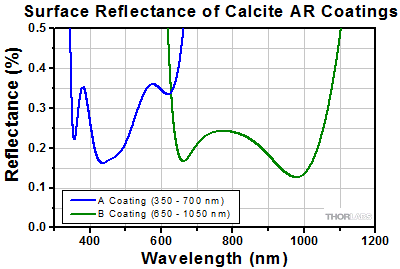
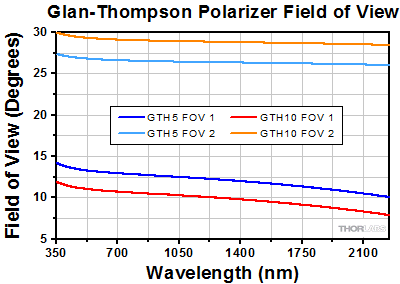


 Glan-Thompson Calcite Polarizers, Mounted
Glan-Thompson Calcite Polarizers, Mounted